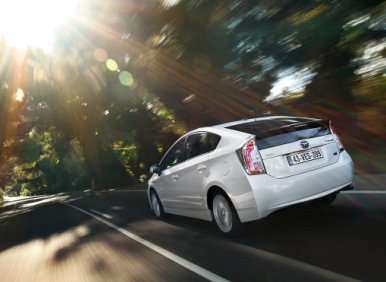Recent Articles
Popular Makes
Body Types
Toyota Prius Used Car Buyer’s Guide

The car every human brain in the developed world forms a mental image of whenever the word “hybrid” is spoken in reference to an automobile, the Toyota Prius, while not the first hybrid on the market (Honda’s Insight owns that honor), is easily the most popular. In every city, in every town, Toyota’s ubiquitous gasoline electric auto can be found. Ironically dismissed as a mere “science project” by a noted Detroit automotive executive when it was introduced, Prius has instead spawned an entirely new automotive segment.
The 2001 model year saw the introduction of the Prius to the North American market. However, Toyota, before introducing an untried vehicle into the world's largest automotive marketplace sold the car for three years in Japan before exporting a revised version to the United States. Today, the Prius is sold in over 70 countries around the world. By 2008, one million of the omnipresent hybrid models had been sold worldwide. By 2010, two million had been sold. As of February 2012, 2.5 million Toyota Prius models had found owners, with one million of those in the United States.
Not content to rest on its hybrid laurels, Toyota has actively expanded the Prius line. There is a standard hatchback version, an extended length hatchback version, a subcompact hatchback version, and a plug-in version of the world's most popular hybrid model. Because of this, a new naming nomenclature has been introduced. The standard Prius is now known as Prius Lift Back, the extended hatchback version is known as Prius v, the subcompact is known as Prius c, and the plug-in is referred to as the Toyota Prius Plug-In Hybrid.
The Prius takes its name from a Latin word meaning "before". Toyota representatives say the name was chosen because the Prius was launched before environmental awareness became a mainstream social issue. And, while that is debatable, there have been three generations of the Toyota’s first hybrid sold in North America since the Prius was introduced here in 2000 as a 2001 model.
Toyota Prius Used Car Buying Guide: 2001 – 2003
The first generation of the Toyota Prius introduced to North America was actually the second version of the Prius and was classified as a compact car. Toyota debuted the concept of the hybrid model in 1994. The production version went on sale in Japan in December of 1997. Its styling was done in Toyota’s Calty design studios in Newport Beach, Calif. (near Los Angeles). An updated version of that car, introduced as a 2001 model, offered more power, air-conditioning, and electric power steering, in a nod to American tastes.
One of the things that really helped the sales of that car take off was a $2000 federal tax deduction offered by the United States government in an effort to get more low emission vehicles on the road. As with every hybrid model following it, the original Prius paired a gasoline engine with an electric motor. The 2001 Toyota Prius’ 1.5-liter in-line four-cylinder gasoline engine made 70 hp and 82 foot-pounds of torque. The electric drive motor added another 44 hp to that total, making the maximum potential horsepower 114.
In one way, that Detroit executive was right. That first Prius was something of a science experiment for Toyota; in fact it is said the company subsidized the sale of each unit of the first version of the Prius. However, the company broke even on the sales of the second version and every version of the car since has been wildly profitable. So much so, the Prius is responsible for nearly 72% of Toyota Motor Company's hybrid sales of over 4 million Lexus and Toyota models sold worldwide, since 1997.
In other words, this is indeed the car that started it all.
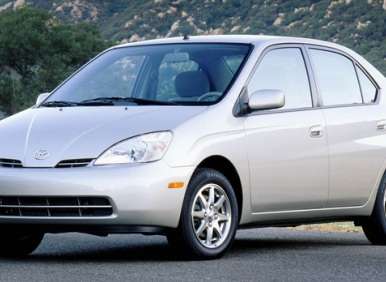
Toyota Prius Used Car Buying Guide: 2001
The sealed nickel metal hydride battery pack powering the electric motor was recharged using energy captured from the regenerative antilock braking system. Coasting would also generate electricity to recharge the batteries. If all else failed, energy from the gasoline engine would be diverted to recharge the battery pack.
The 2001 Toyota Prius was offered in but a single trim line, however that trim line encompassed a generous complement of standard equipment. The car used 14-inch alloy wheels, an inside mounted temporary spare tire, variable intermittent wipers, a rear defogger, and a manual rear sunshade.
The front-wheel-drive Toyota used a continuously variable automatic transmission, MacPherson strut front suspension, torsion beam rear suspension, and ran on regular unleaded fuel. Remote power door locks, power mirrors and power windows were standard equipment—with the driver's window capable of being operated with one touch. The front console featured storage; there were front and rear cupholders, front door pockets, front seatback storage, and a remote trunk release. The tilt adjustable steering wheel controlled an electric power steering system.
The climate control system benefited from interior air filtration, and the sun visors contained a pair of vanity mirrors. The Toyota also featured a clock, a trip computer, and a low fuel level warning indicator. The base audio system used an AM/FM head unit with four speakers.
Options included alloy wheel locks, an in-dash six-disc CD changer, a single disc compact disc player, a cargo mat, a cargo net, and four carpeted floor mats.
Standard safety features included four-wheel ABS, child seat anchors, an antitheft alarm system, rear door child safety locks, and engine immobilizer, a rear center three-point safety belt and front seatbelt pre-tensioners. The model also got electronic brake force distribution, and an emergency interior trunk release. The optional safety feature was a glass breakage sensor.
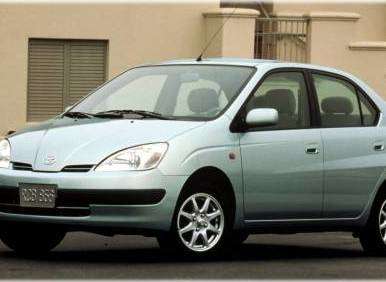
Toyota Prius Used Car Buying Guide: 2002
For model year 2002, the Prius returned in but a single trim line, however new options were offered including a GPS navigation system, cruise control, side/curtain airbags, and daytime running lights.
Toyota Prius Used Car Buyer’s Guide: 2003
Prius went into model year 2003 with no changes.
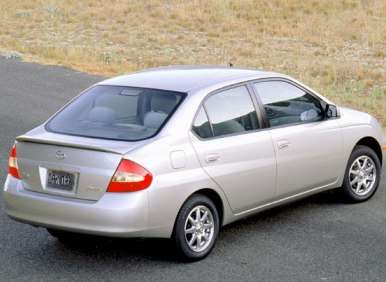
Toyota Prius Used Car Buying Guide: 2004 – 2009
A complete redesign, the second-generation Toyota Prius was large enough to be classified as a midsize model. The revised version of the car offered more power, better fuel economy, and a broader range of available features. The model took advantage of its newly acquired generous dimensions to offer a more spacious interior. This was most notable in terms of rear seat legroom and cargo capacity.
Toyota named the Prius’ powertrain Hybrid Synergy Drive; the revised version once again consisted of a 1.5 L gasoline engine and a single electric drive motor. However, the new gasoline engine made 76 hp and 82 foot-pounds of torque, while the electric motor made 67 hp and 295 foot-pounds of torque. The 2004 Toyota Prius was the first car to use an all-electric air conditioning compressor for cooling. An electronically controlled continuously variable automatic transmission routed the output of the powertrain to the front wheels.
While this doesn't sound like a lot of power for a car designed to carry four adults, it is important to recognize the 2004 Toyota Prius had a curb weight of only 2890 pounds. Despite its light-weight however, the model scored a five-star driver and a four-star passenger rating in the National Highway Traffic Safety Administration's frontal collision test. The Insurance Institute for Highway Safety gave the 2004 Prius a “good” overall score.
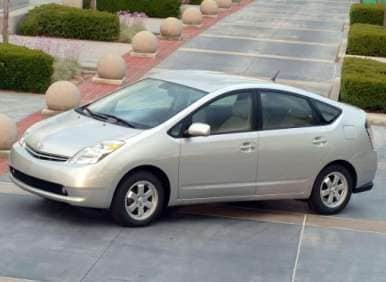
Toyota Prius Used Car Buying Guide: 2004
A larger car than the model it replaced, the 2004 Toyota Prius used 15-inch alloy wheels. Variable intermittent windshield wipers and the rear defogger returned as well. The cargo compartment featured tie downs and cloth upholstery was standard equipment. Also like the model it replaced, the 2004 Prius used a MacPherson strut front suspension system and a torsion beam rear suspension system.
The split folding rear seat back featured a folding center armrest. The model used remote power door locks, heated power exterior mirrors, and power windows with a one-touch feature for the driver. The front console featured storage; there were front and rear cupholders, front door pockets, and front seat back storage. The tilt adjustable steering wheel contained audio controls and controlled an electric power steering system.
The 2004 Toyota Prius retained accessory power when the engine was shut off and featured a 12 V front power outlet. The climate control system featured interior air filtration, there was a cargo area light, a set of front reading lights, and dual vanity mirrors (one in each of the sun visors). Rounding out the standard equipment list were a clock, a trip computer, an external temperature display, and a low-fuel warning indicator. The audio system was comprised of an AM/FM–single disc CD player. The head unit fed six speakers.
Options included a voice-activated DVD-based navigation system, Bluetooth hands-free phone technology, keyless entry and ignition, and a JBL premium audio system with a six-disc CD changer. Other significant optional features included an electrochromic auto-dimming interior rear-view mirror, a wiper for the glass in the rear hatch, and xenon headlights.
Standard safety gear included four-wheel ABS, a set of child seat anchors, emergency braking assist, emergency brake force distribution, traction control, and tire pressure monitoring. There was an engine immobilizer, a rear center three point seatbelt, and front and rear seatbelt pre-tensioners.
Toyota also offered an eight-year/100,000-mile warranty on the hybrid components. These included the battery pack, the electric motor, and the regenerative braking system.
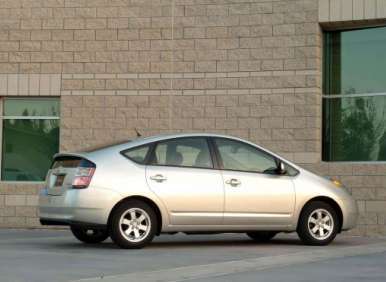
Toyota Prius Used Car Buying Guide: 2005
A wiper was added to the rear window for the 2005 model year, the material used for the sun visor was switched to fabric, and the Prius’ Smart Entry and Start system was renamed the Smart Key system.
Toyota Prius Used Car Buyer’s Guide: 2006
An optional backup camera was headed for model year 2006. The exterior styling was updated with new headlights and taillights. The interior gained leather upholstery and an audio input jack as options.
Toyota Prius Used Car Buyer’s Guide: 2007
A second trim line was added for 2007, in an effort to imbue the Prius with more sporting flavor. Toyota's product planners came up with the 2007 Toyota Prius Touring model. This version of the cars featured a sport tuned suspension system, 16 inch alloy wheels, fog lamps, xenon headlights as standard equipment, and a larger rear spoiler. Front seat side airbags and full-length head curtain airbags were made standard equipment for both models.
Toyota Prius Used Car Buyer’s Guide: 2008
To lower the price of entry, a slightly de-contented “Standard” Prius trim was introduced. However, given how well the Toyota hybrid was outfitted in the first place, removing those two items did little to compromise the enjoyability of the car.
Toyota Prius Used Car Buyer’s Guide: 2009
With an all-new third generation Prius on launch pad, Toyota's best-selling hybrid went into model year 2009 with no significant changes.
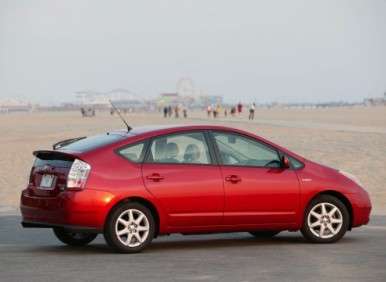
Toyota Prius Used Car Buying Guide: 2010 – Current (2012)
The third-generation Toyota Prius, introduced in March of 2009, as a 2010 model, was yet another complete redesign. Enhancements to the concept included more power, better fuel economy, improved steering, and sleeker styling. This model of the Prius also incorporated the ability to park itself.
Rear disc brakes were added for the first time, the displacement of the gasoline engine was increased to 1.8 L and the corresponding output was improved as well to 98 horsepower. Combined power output (incorporating that of the electric motor) was a total of 134 hp. The new engine employed added an electric water pump to the electric power steering pump, so it needed no accessory drive belts. The hybrid powertrain features, including the electric motor and the inverter were smaller and lighter.
Plant derived bioplastics were used in the construction of the car, made from cellulose derived from wood and grass instead of petroleum. On the safety front, the IIHS rated the 2010 Prius as Good except for its side-impact structure/safety cage performance, which was rated Acceptable.
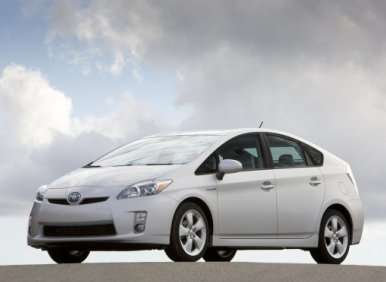
Toyota Prius Used Car Buying Guide: 2010
While the Prius had always been a nicely equipped car, the all-new 2010 model took that proposition to new heights. For the first time, the Prius was offered in five trim levels. Designated using Roman numerals, they were Prius I, Prius II, Prius III, Prius IV, and Prius V.
Prius I featured 15-inch wheels, variable intermittent windshield wipers, a rear defogger, cargo tiedowns, a height adjustable driver seat, cloth upholstery, and a split folding rear seat back with a folding storage center armrest. The model offered remote power door locks, power mirrors, and four one-touch power windows. The front console featured storage; there were front and rear cupholders, front door pockets, and an overhead console with storage.
Prius I retained accessory power when the engine was shut off and offered a 12-volt front power outlet. The tilt and telescopic steering wheel controlled an electric power system and incorporated audio and cruise controls on the steering wheel. Meanwhile, the climate control system benefited from interior air filtration. There were a pair of front reading lights, and a cargo area light. A clock, the trip computer, and external temperature display, a low fuel level warning indicator, and a compass were also standard equipment.
Options included an emergency assistance kit, a carpeted floor and cargo mat set, an auto dim interior rearview mirror, an iPod interface kit, a first aid kit, satellite radio, the cargo organizer, a cargo net, and the cargo tote.
Safety features included four disc brakes with ABS, front and rear head airbags, dual front side-mounted airbags, a set of child seat anchors, rear door child safety locks, a passenger airbag occupant sensing deactivation system, a rear center three-point safety belt, and front seatbelt pre-tensioners. An engine immobilizer, emergency braking assist, electronic brake force distribution, stability control, traction control, and a tire pressure monitoring system were also standard safety features.
Prius II added keyless ignition/entry, auto on/off headlights, a hybrid system display, and a six-speaker stereo with a CD player and an auxiliary audio input jack.
Prius III supplemented all of that with Bluetooth and an upgraded eight-speaker audio system with a six-disc CD changer.
To all of the above; Prius IV added exterior locking buttons for keyless entry, leather upholstery, heated front seats, driver lumbar adjustment, and an electrochromic auto-dimming inside rearview mirror.
The full-boat Prius V’s feature set was comprised of everything from the other four versions, plus 17-inch alloy wheels, fog lights, and auto-leveling LED headlamps with an integrated washer system.
Optional packages included Navigation, Solar Roof and Advanced Technology.
The Navigation package was available on all but Prius I and II, and included a voice-activated touchscreen navigation system with real-time traffic reporting, a back-up rear view camera, a four-disc CD changer (which supplanted the six-disc changer), and Bluetooth music streaming.
The Solar Roof package could be added to the Navigation package. As its name implied, this was comprised of a sunroof with an embedded solar array, which energized the solar-powered ventilation system intended to cool the car when it was parked.
The Advanced Technology package, sold in conjunction with the Navigation package bought adaptive cruise control, a pre-collision alert system, a lane departure warning system, and the automated self-parking feature we mentioned earlier.
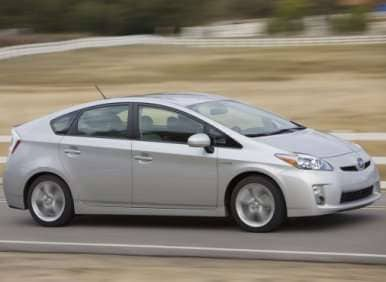
Toyota Prius Used Car Buying Guide: 2011
Prius went into model year 2011 with no significant alterations. However, mid-year changes were introduced that applied to 2012 models. The exterior changes included updated headlamps, revised tail lamps, and a distinctive front fascia and bumper.
Toyota Prius Used Car Buyer’s Guide: 2012
With the appearance of the larger Prius v model, it became necessary to scrap the Roman numeral nomenclature system in favor of an Arabic numeral nomenclature system. Thus Prius I, II, III, IV, and V became known as Prius 1, 2, 3, 4, and 5.
Minor styling tweaks freshened the appearance of the 2012 model year Toyota Prius. Prius 1 was relegated to fleet sales only, and the technological trickle-down theory saw Bluetooth phone and audio connectivity, dedicated iPod control, and the touchscreen electronics interface migrated to Prius 2, making those features standard on all consumer-model Prii.
Toyota's new Entune system, bundling satellite radio-sourced real-time weather, sports and other useful information with a suite of apps that connected the Prius to the Internet via a paired smartphone was offered for all trim levels, except the entry-level Prius 2. With Entune, it became possible to wirelessly stream Pandora and iHeart Radio through the Prius’ sound system.
A key addition was Toyota's Vehicle Proximity Notification System (VPNS), designed to alert pedestrians, the blind, and others of the vehicle's presence. This was incorporated as a safety feature due to significant noise reduction typical of a hybrid vehicle traveling at low speeds in all-electric mode.
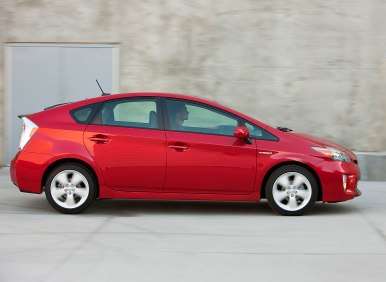
Toyota Prius Used Car Buying Guide: Summary
Offering previously unobtainable fuel economy along with a seamless driving experience, a spacious interior, a strong feature set, and a reasonable price; the Toyota Prius virtually rules the hybrid marketplace.
Over the years, the Prius has proven itself capable of long-term durability, as stories of battery or other hybrid component failures are practically nonexistent. In fact, there are a number of Prii on the road that have traveled well in excess of 200,000 miles. As a used car purchase, a pre-owned Prius should serve you very well. There is however, one caveat. The car is quite complex and should aspects of the hybrid system fail, in all probability they will be considerably expensive to replace.
Toyota alleviates some of this concern with an 8-year/100,000 mile warranty for the hybrid components on all Prius models. Still, you’ll do well to subject any used Toyota Prius you're considering purchasing to a very thorough pre-purchase inspection by a trusted professional independent mechanic—one familiar with the Toyota hybrid’s powertrain system.
Similarly, a vehicle history report (VHR) run against the VIN of any model you're seriously considering purchasing will add peace of mind to your purchase. The VHR will tell you if the car has ever been involved in a significant accident, if its title is clean, and will also give you insights into its service history.
As bulletproof as Toyota models are, there have been recalls for the Prius. To find out which (if any) apply to the model year of your interest, run an Internet search for Toyota Prius recalls.
